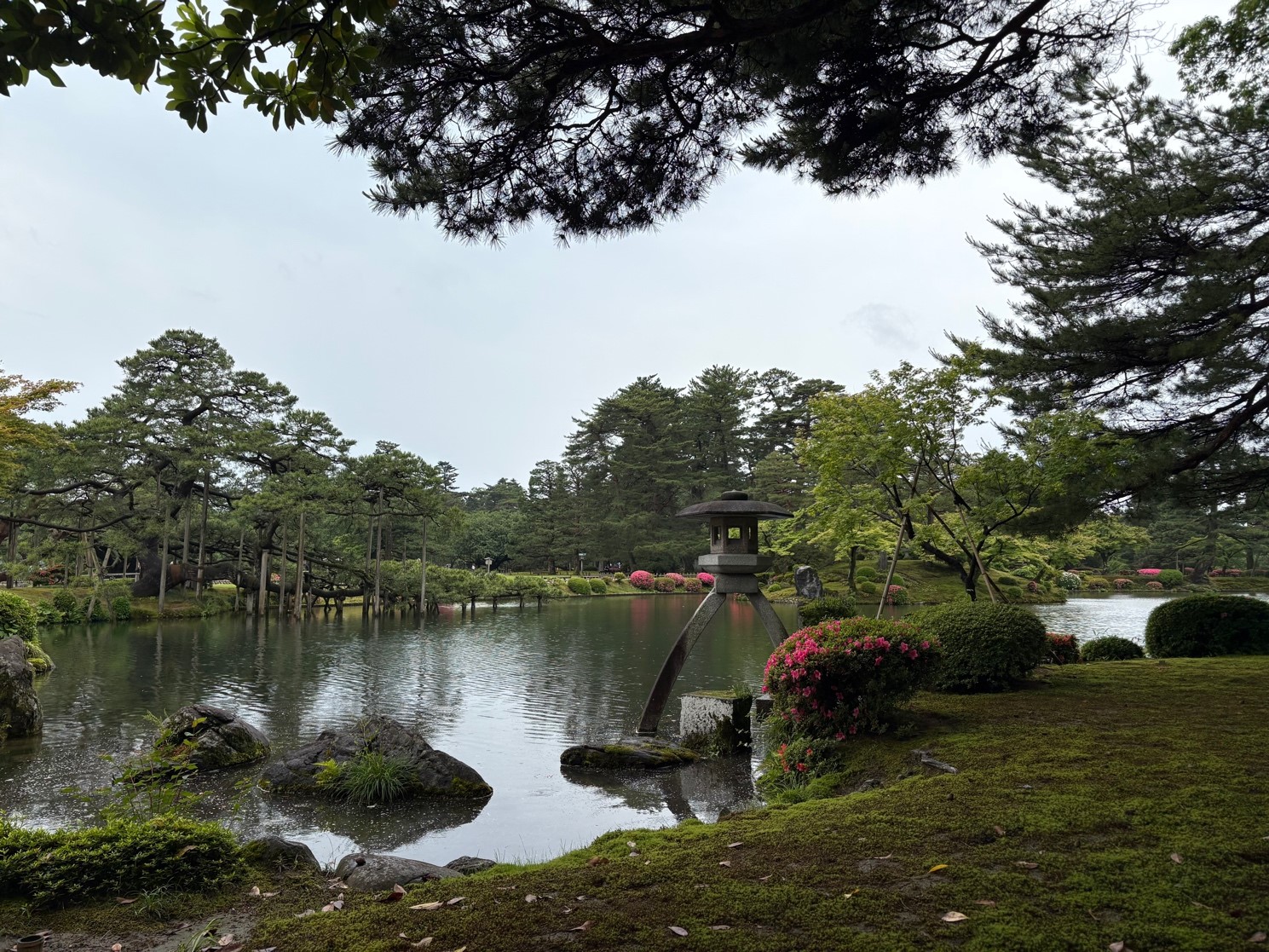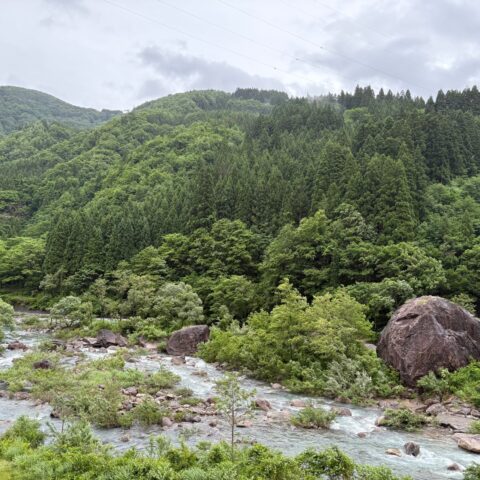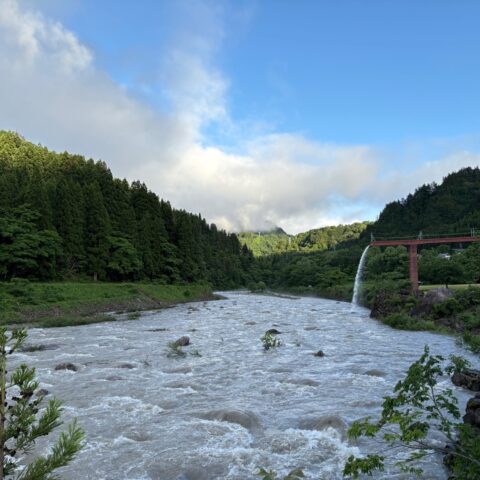Japanese Culture & Local Life Experience Program in Kanazawa & Shiramine
There were many experiences in throughout the program that will be useful to my future career.

現地の人との交流について印象に残ったことは?
How was your experience interacting with local people?
Interacting with the local people was very refreshing and rewarding. Everyone I had the pleasure of interacting with was very friendly. Even when interacting with a store clerk, I felt welcomed. In the beginning I was very nervous to interact with local people because I know very little Japanese. But it did not ever seem like the language barrier was a barrier. I was able to communicate with everyone, even though we did not speak the same language. Towards the end, I felt more confident going into shops and restaurants. It was also wonderful having Susan translate for us while we were in Shiramine. That really helped highlight the character of everyone throughout the village, and it made me feel more of a connection to Shiramine. Now I tell everyone about it, and I would love to help boost tourism there.
I also noticed a very high work ethic all throughout Japan. I think this high work ethic contributes to the conservation mindset that runs throughout Japan. There is a great sense of pride that goes into everything that is done. So that leads to preservation of resources, because it is recognized how precious those resources are to the people and to the economy of Japan.
I believe that these interactions with the local people of Kanazawa and Shiramine will help my academic career and beyond because now I have hands-on experience in problem solving with people of various backgrounds and cultures and how this may influence ideas or lead to different interpretations of an issue. In the future, I plan on collaborating with people from other cultures and backgrounds to bring different views into decision making because it could help paint a more holistic view of the issue and help create solutions that would have never been thought of.
I also believe that these interactions will help with my future career because climate change is global, making sustainability and conservations efforts a global priority. Because of this, I believe that I will be working with people all throughout the world, and I will now be able to take the issues that I faced while in Japan, and solutions that I found to help create a global solution for climate change and increase sustainability and conservation efforts around the world.
プログラム期間中の活動で特に印象に残ったこと
Please write about what left a strong impression on you during the program period.
There were many things that left a strong impression on me throughout this program. But the thing that left the strongest impression was seeing how important preservation of tradition is to Japanese culture and how that translates into conservation and sustainability efforts. In Shiramine I enjoyed learning how to make traditional crafts made from local materials and traditional dishes from local foods, as well as getting to know the people of Shiramine and what their vision for the future is. I really noticed the strong connection between Japanese culture and the natural world in Shiramine. For example, all food I ate was from the Mt. Hakusan area like mountain vegetables and Katadofu, the sake we tried was made locally using Hakusan water, and the buildings were constructed using materials from around Mt. Hakusan. It was very impactful to see how connected the people of Shiramine were to nature and how deep the appreciation of nature goes. It was also impactful to see how buildings were getting repurposed around the village to try to incorporate modernity with tradition. In the United States we do not have that same mindset. We tend to demolish things that are “outdated”, and we do a poor job at maintaining what we do have. So, it was very refreshing to see that buildings can be cared for and repurposed despite being hundreds of years old. I believe if we promoted the conservation mindset that I experienced in Shiramine, in the United States, it could help drive conservation by eliminating some of the demand for finite materials because we are repurposing what we already have. But I know there would have to be an extreme shift in mindset in the United States in order for it to work, so I have started to ask the question of how can we bring people closer to nature in the United States? How can Americans make nature a part of their culture? I did also notice similar efforts around Kanazawa. It seemed as if the city was a perfect mix of modern and historical. For example, the Higashi Chaya District had many modern shops within its historic walls that offered goods specific to Kanazawa. Or how you can take a bus to Kenroku-en Gardens to see 300-year-old trees in the middle of the city. Kanazawa also seemed built around nature instead of the other way around. I noticed many streets had channels of water running through them to manage rainfall and prevent flooding, and that buildings were constructed with the natural gradient instead of manipulating the gradient to fit the building. All in all, I left with a very strong impression that Japanese culture and Japanese people are very connected to nature which could make them a leader for the rest of the world to look to in adopting sustainable practices in the wake of climate change.
プログラム中の経験で将来のキャリアのために役立つと思うこと
What was a useful experience for your future career among your experiences during the program?
There were many experiences in throughout the program that will be useful to my future career. Ultimately, I would like to go into the field of sustainability goal planning and helping entities achieve those goals. So I would have to say that the second day in Shiramine when we visited the Hakusan Alpine Garden, the Sabo Science Museum, and had the meeting with the National Park Ranger to learn how parks are managed in Japan were the most useful experiences. I thought that many of the things I learned could be applied in the United States and throughout the world to help increase conservation and sustainability efforts. In the Hakusan Alpine Garden we learned about how many of the alpine flowers were going extinct and how the community noticed this issue. So, to combat it, they brought seeds down from the alpine zone to grow in a different area to ensure their continued survival. It was amazing to me to see how quickly an issue could be identified by a community and solved by them. To me, this really highlighted the importance of community and local input in decision making. In the United States, we tend to overlook community input and create policy based on economic value rather than intrinsic value, so many communities are left to suffer if a policy does not include them. For my master’s thesis, I want to learn how policy can be improved on by employing critical and participatory GIS techniques to incorporate community opinion to make sure everyone is accounted for. So, the alpine garden reminded me how important it is to get the community involved to ensure conservation.
The information about erosion control efforts in Japan at the Sabo Science Museum will also be very useful to my future career. In the United States, we tend to have issues with flooding because our infrastructure maintenance is severely lacking are cities are built on floodplains, so it would be interesting to see if Sabo dams or a design similar could help with flood control since they slow the water down. Colorado and other mountainous areas also experience erosion. So, I am interested in applying the erosion control efforts that are taken in Japan to these areas in the United States, like placing a net over unstable rocks and planting plants on them to slow erosion down. Or using a Sabo dam system to see if slower water would help slow erosion in these areas. I am also interested in seeing if slower water coming down the mountain could translate into more water for human consumption. For example, if we had a Sabo dam system in the Rocky Mountains, would the Colorado River have more flow, and could this help uphold the Colorado River Compact that is suffering due to drought? I know it may seem like a stretch, but I am interested in applying everything I have learned in Japan to try to help sustainability efforts in the United States and other places that may be struggling. But I am also interested in learning about what Japan thinks they could improve on and see if there is anything we are doing in the United States that could help there.
Another experience that I will take with me to my future career would be the lecture from the Mt. Hakusan Park Ranger. One thing that really stood out to me in the lecture was that the parks tend to be owned by the Shrine, not by the government which is very different than the United States. I thought this was very interesting because a vested interest is the owner rather than the government which could switch focuses and efforts regarding parks, especially with how frequently they change in the United States. For example, the current administration in the United States is interested in selling off large parts of our federally owned land to private interests, whereas the previous administration made efforts to secure more federally protected land. Having the land owned by a vested interest could eliminate some of the uncertainty around land ownership and whether it will be protected for future generations. Another thing I found to be interesting is that there are many different groups of people invested in the National Parks of Japan. This makes managing the park a collaborative effort where relationships are built over years. This was interesting to me because in the United States, the different branches of government really have the final say in what gets managed, how it gets managed, and who manages it. This could lead to corruption if the wrong people are elected. So, it would be interesting to dig deeper into the way Japan manages their parks and to see if the United States could come up with a different, more inclusive approach to park management.
次年度以降、同じプログラムに参加する学生に伝えたいこと
Comments for students who will participate in the same program next year.
I would say that learning about Japanese culture is very important before going on this trip. Even little things like where to place your chopsticks while not in use. This will help greatly to portray that you respect Japanese culture, and you are here to learn about it and embrace it. It is also helpful to learn key phrases before departing. Even if you do not know Japanese, it makes it a lot easier to know how to say hello, good morning, excuse me, and thank you. This will also help show that you are respectful. It is helpful to convert at least some money before departing. This way you can get food in the airport after a long flight.
As for preparing academically, it is important to research sustainability efforts in Japan, this will help you make connections while you are there. It was also helpful to bring a notebook and folder for paperwork. I was able to take notes throughout each lecture to reference back to throughout the program. These notes also helped me figure out what I want to research further and how I can incorporate these methods in the United States or how the United States could help Japan with their efforts.
Finally, the days will fly by, but the information learned will last a lifetime if you take this program seriously and immerse yourself in it.
渡航前・渡航後のCOILを含め、プログラム全体を通しての感想
Feedback on the program, including COILs before and after trips to the US/Japan.
All in all, the program was wonderful. This was definitely a once in a lifetime experience that I will never be able to replicate. If I visited Kanazawa and Shiramine on my own, I never would have gotten the in-depth information that I received from this program. I think the structure of the program really made me see how connected to nature everything is in Japan. I would not have noticed how the streets are even structured to cater to nature and mankind. So, I would say the structure of the program was perfect for someone looking to explore conservation efforts abroad. I would say the balance of free time and work was also very considerate. I was able to go out and learn and then have my evenings free to explore Kanazawa and create relationships with the others in this program. I also thought the faculty at Kanazawa University was very thoughtful in planning the travel, accommodations, and activities. The staff at the International Relations Department was very detail oriented and made sure to communicate everything to us to ensure our success with this program. The information provided beforehand was very helpful in setting the expectation for our purpose in Kanazawa and Shiramine. It was also nice to sort of “meet” the local people we interacted with in Shiramine before we went. I thought that the H-1 form, activity report, and rubric were all helpful tools to reflcet on this program. Though it was only 10 days, I will carry this experience with me for the rest of my life, and find new ways to incorporate what I have learned about conservation and sustainability in Japan to better areas around the world for the future, as well as taking what I have learned in my academic career to better conservation efforts in Japan to hopefully have a lifelong partnership between us.

The historic boulder that we learned about at the Sabo Science Museum. This boulder was left as a reminder of how powerful the river can be, but also how powerful and resilient a community can be. The flood that brought this boulder spurred the flood and erosion control efforts that Japan still uses today. 
The drainage channels that line the sidewalks and streets drains out to increase flow to the river and prevents flooding of the streets. This shows how every aspect of Shiramine was planned out to benefit nature and mankind.
